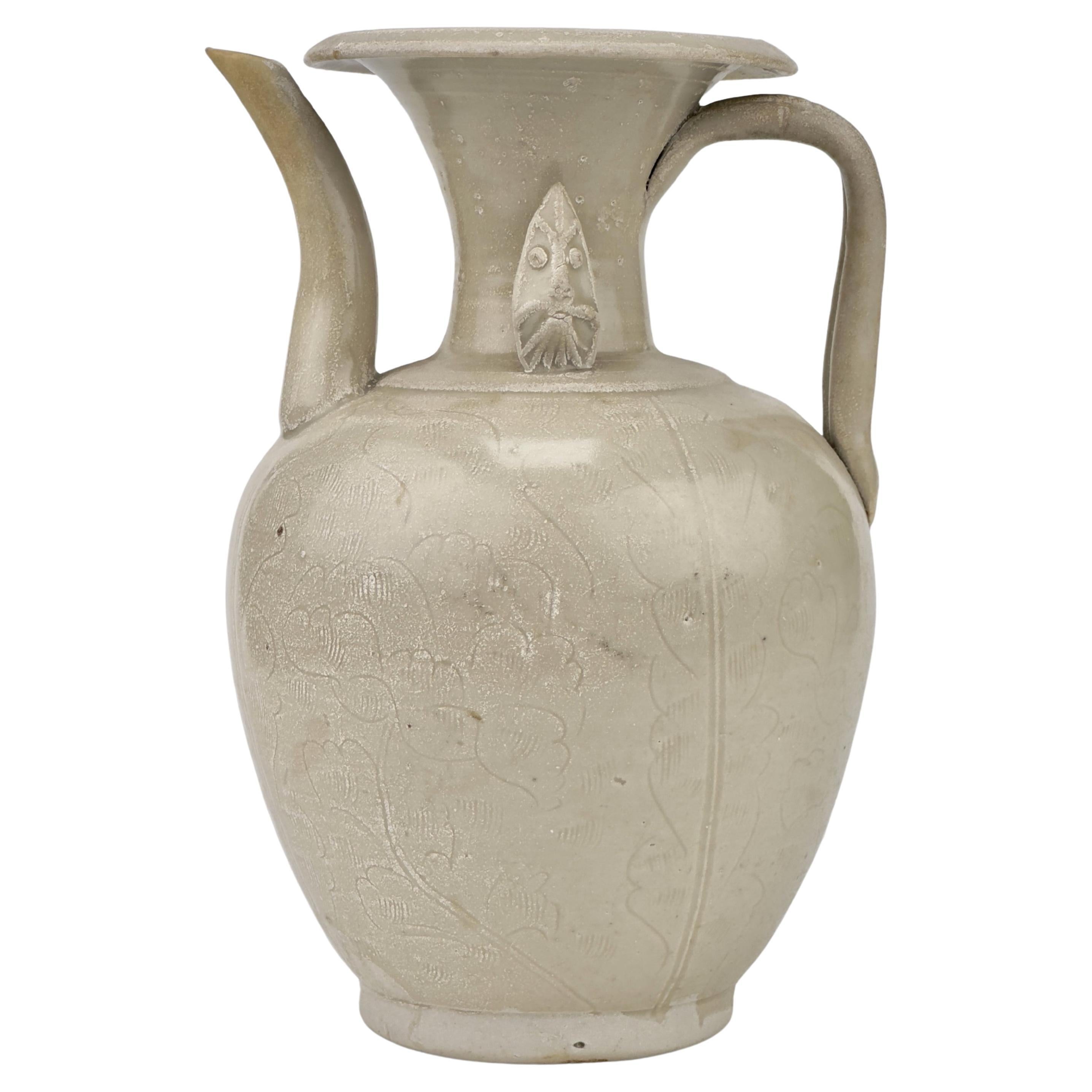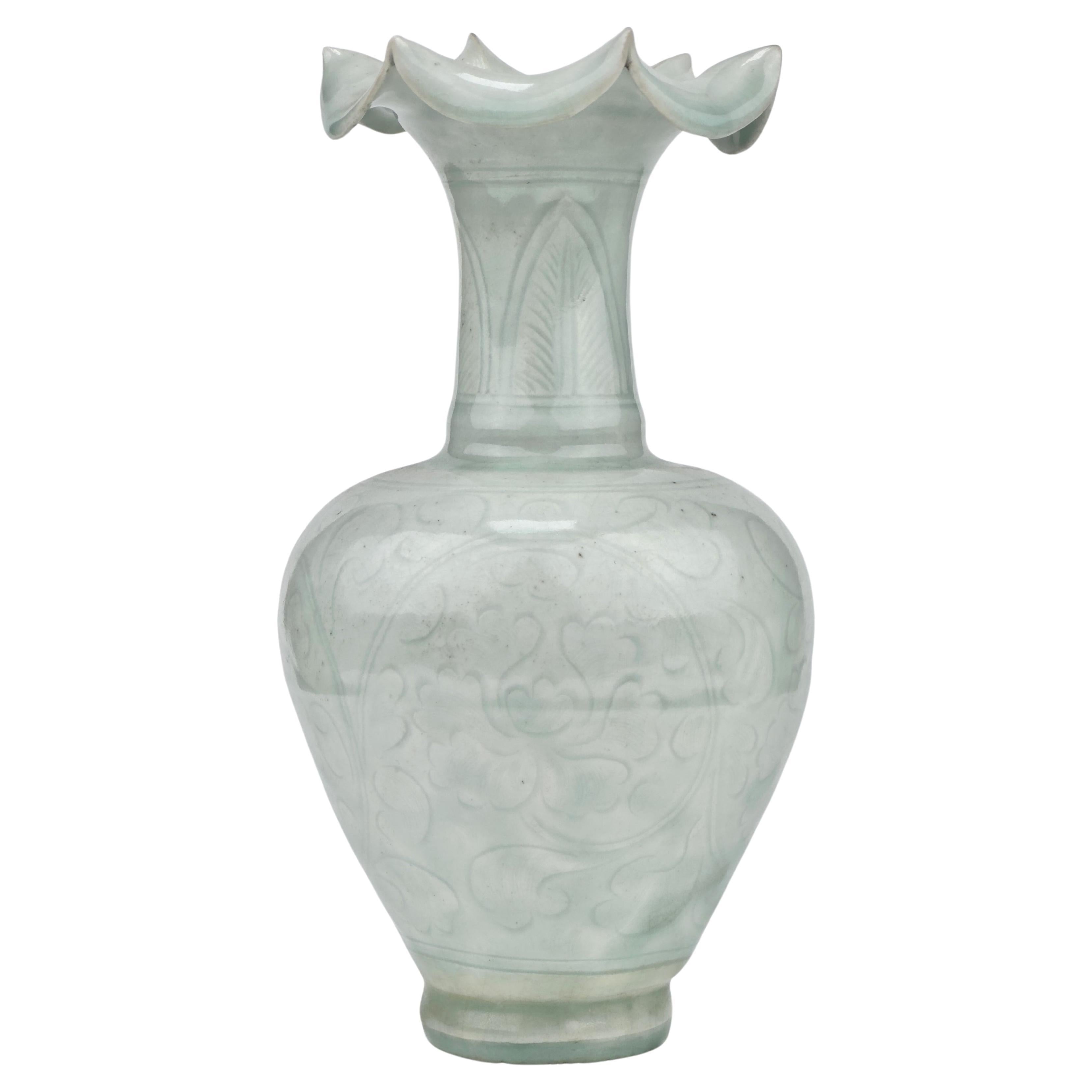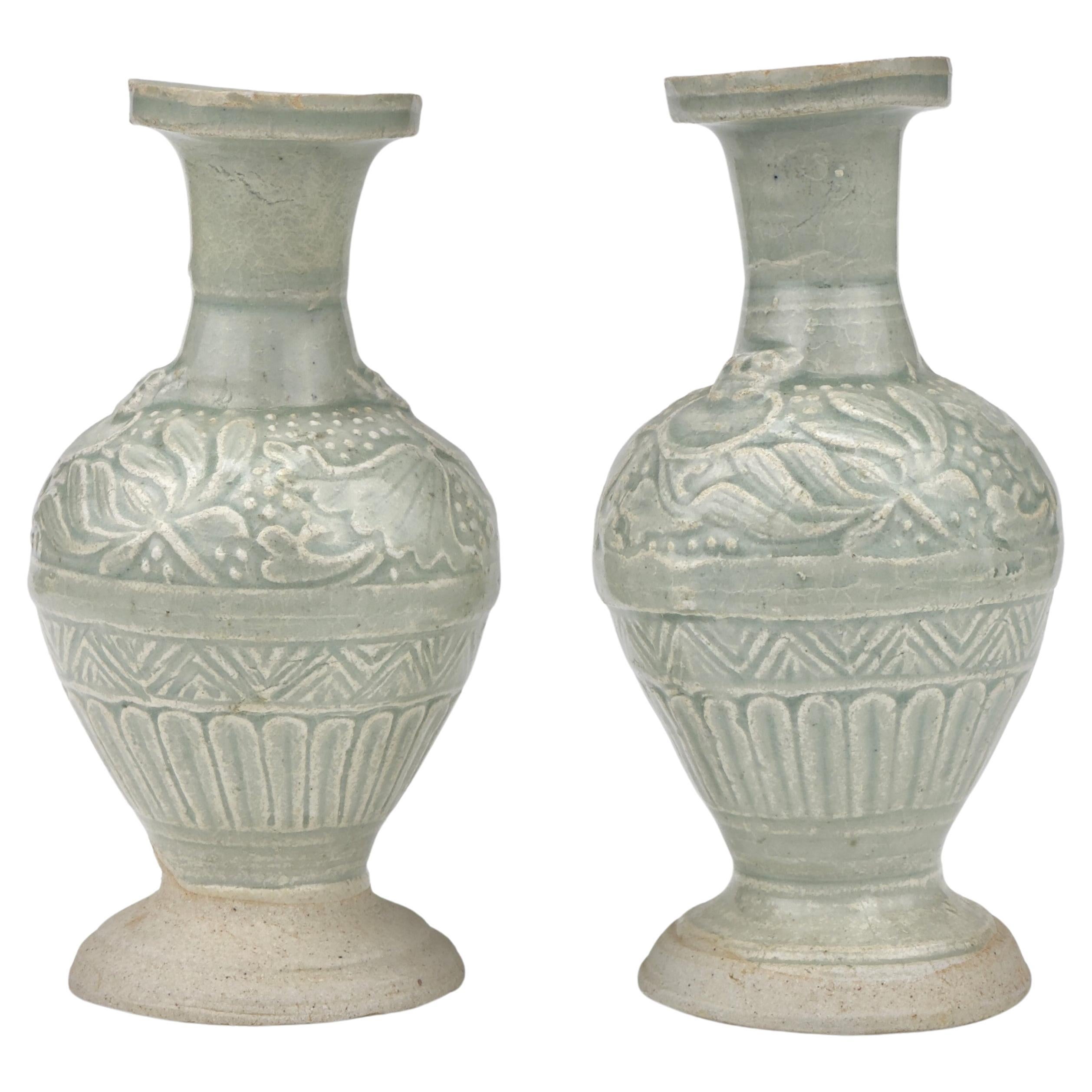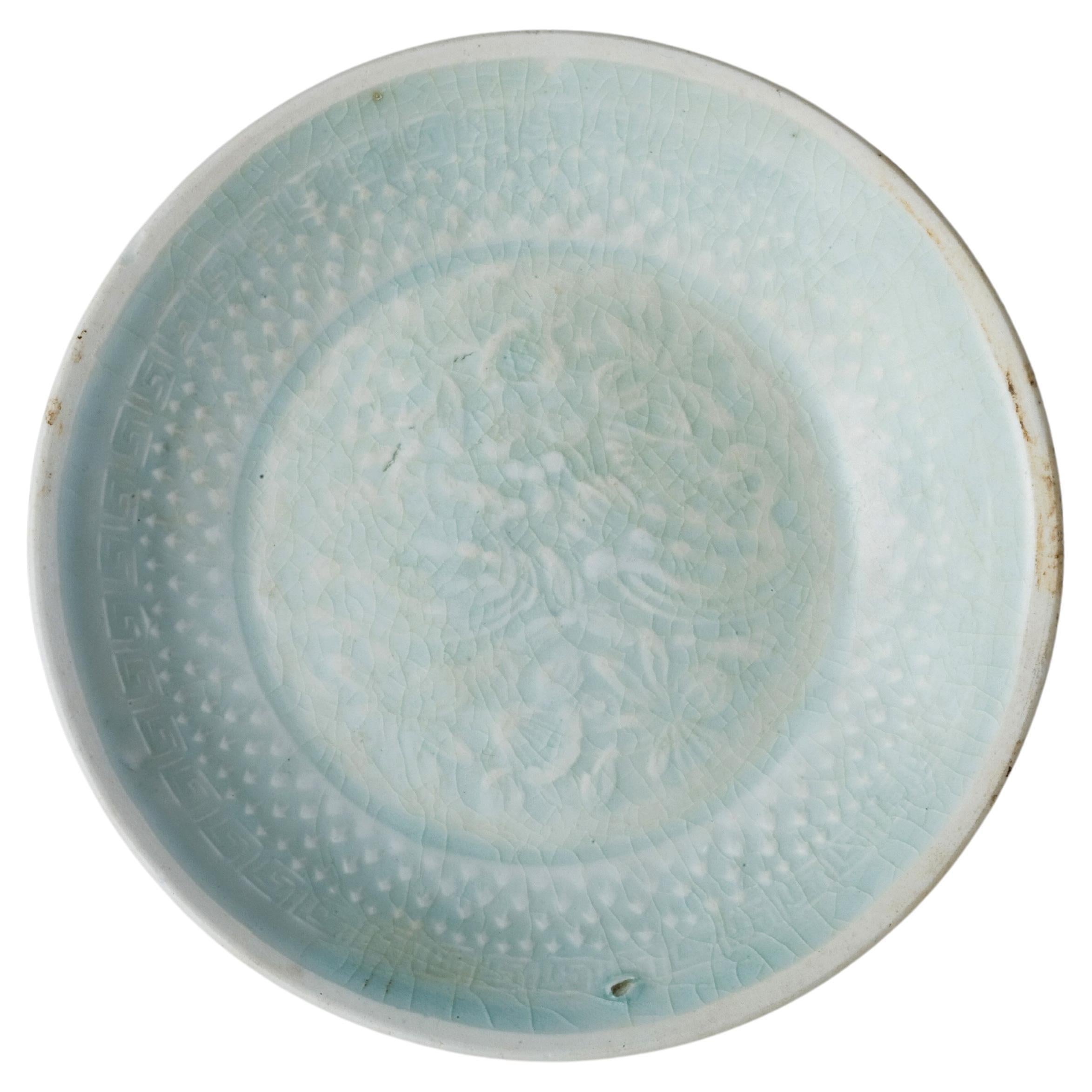Items Similar to Small Qingbai Pear-Shaped Vase, Song-Yuan Dynasty(13-14th century)
Want more images or videos?
Request additional images or videos from the seller
Small Qingbai Pear-Shaped Vase, Song-Yuan Dynasty(13-14th century)
About the Item
This exquisite piece is a Qingbai ware from the Song to Yuan dynasty, and it appears to be an excavated artifact given its earthy encrustations, suggesting it has rested in the ground for a lengthy period. Despite this, the piece retains its signature Qingbai glaze, which is characterized by its luminous, pale blue hue. The vase itself has a graceful, elongated neck flaring gently at the mouth, reminiscent of a blooming flower. Standing on a squared, hollow base that gives it a distinctive silhouette, the vase demonstrates the elegant simplicity and refined craftsmanship of the period.
Period : Song-Yuan Dynasty(13-14th century)
Type : Small Ewer
Medium : Qingbai Ware
Size : 13.5 cm(Height), 4.5cm(Diameter)
Provenance : Acquired in late 1990s from Hongkong
Reference :
1) Christies Newyork 1–15 DEC 2015 - Exquisite Splendor: Chinese Ceramics And Works Of Art - Lot 68
(Price realised : 3,750 USD / Type : Closely related)
* Qingbai Ware
Qingbai ware, which translates to "blue-white ware," is a type of Chinese porcelain that was made at the Jingdezhen and other kilns in the porcelain-producing regions of China, primarily during the Song dynasty (960–1279) and continuing into the Yuan dynasty (1271–1368). It is known for its translucent quality and the pale blue-green glaze that characterizes most of its pieces.
The qingbai glaze was achieved using a small amount of iron in a reduction-fired atmosphere, which produced the subtle blue-green tint. The body of qingbai ware is typically made of a fine, white porcelain that is often referred to as 'artificial jade' due to its resemblance to the esteemed stone. The thinness of the body and the high firing temperatures used contributed to the translucent quality of the finished product.
Qingbai ware includes a range of items such as bowls, cups, vases, and ewers. The designs are usually simple and elegant, with an emphasis on the graceful lines and form of the objects. Decorative motifs, when present, are often incised, carved, or molded in relief and can include floral patterns, dragons, phoenixes, and other symbolic elements drawn from Chinese culture.
Over time, the technology and techniques used to produce qingbai ware evolved, leading to innovations in glaze and decoration that would influence later types of Chinese porcelain. Despite these changes, qingbai ware remains a distinguished example of the potters' art in Song and Yuan China, reflecting the refined aesthetic and cultural values of the period.
- Dimensions:Height: 5.32 in (13.5 cm)Diameter: 1.78 in (4.5 cm)
- Style:Ming (Of the Period)
- Materials and Techniques:
- Place of Origin:
- Period:
- Date of Manufacture:13-14th century
- Condition:Minor fading. One chip on the mouth.
- Seller Location:seoul, KR
- Reference Number:1stDibs: LU9577239477842
About the Seller
New to 1stDibs
Joined in the past six months.
4.5
Vetted Seller
These experienced sellers undergo a comprehensive evaluation by our team of in-house experts.
Established in 1999
1stDibs seller since 2023
Typical response time: <1 hour
- ShippingRetrieving quote...Ships From: seoul, Korea South
- Return PolicyA return for this item may be initiated within 10 days of delivery.
More From This SellerView All
- A Carved Qingbai 'Chrysanthemum' Vase, Song-Yuan Dynasty(13-14th century)Located in seoul, KRThe ovoid body to a tall neck, the body decorated with a chrysanthemum meander, covered overall in a translucent pale blue glaze. Traces of excavation can be seen in the dirt marks o...Category
Antique 15th Century and Earlier Chinese Ming Antiquities
MaterialsCeramic, Porcelain
- Two white ware vases with flower design, Yuan Dynasty, 14th centuryLocated in seoul, KRPorcelain with transparent pale-green (qingbai-type) glaze with flower, leaves and lotus design of typical yuan dynasty. Period : Yuan Dynasty(1271-1368) Type : Baluster vase Medium...Category
Antique 15th Century and Earlier Chinese Ming Antiquities
MaterialsPorcelain, Ceramic
- White Ware with two dragons, Yuan Dynasty, 13-14th centuryLocated in seoul, KRThis vase is made from a type of low-fired, porous clay and features a crackled glaze. It bears resemblance to the renowned funerary vases and covers adorned with applied decorations...Category
Antique 15th Century and Earlier Chinese Chinese Export Antiquities
MaterialsCeramic, Porcelain
- Chinese Qingbai Small Model of a Granary Set, Song DynastyLocated in seoul, KRTwo granary model porcelains. East Asia, This pottery representation of a granary sits on a layered base, topped with a conical lid that also acts as its roof, all finished in a grey...Category
Antique 15th Century and Earlier Chinese Ming Antiquities
MaterialsCeramic, Porcelain
- A Molded Qingbai 'Flowers' Dish, Southern Song DynastyLocated in seoul, KRThe plate depicted here exhibits the intricate floral patterns and lotus motifs that are typical of Southern Song designs. The central floral motif captures the essence of Oriental b...Category
Antique 15th Century and Earlier Chinese Ming Antiquities
MaterialsCeramic
- Qingbai Melon form water ewer, Northern song dynastyLocated in seoul, KRThe oviform body is divided into few lobes, and the shoulder is applied with a pair of small loops molded. Period : Song Dynasty(960~1279) Type : Ewer Medium : Zhejiang celadon Pro...Category
Antique 15th Century and Earlier Chinese Ming Antiquities
MaterialsPorcelain
You May Also Like
- Antique Ceremonial Urns, Song Dynasty, 12th-13th CenturyLocated in New York, NYTwo tall ceremonial urns dating from the 12th-13th century, Southern Song dynasty. These two stunning vases depict 12 traditional ritual attendan...Category
Antique 15th Century and Earlier Chinese Other Antiquities
MaterialsCeladon
- 13th/early 14th C' Sukothai Walking Buddha, 8993Located in Ukiah, CAAll time favorite, and the first Buddha I have not wanted to post for sale in many years, as my heart melted the first time I laid eyes on him and I wanted to claim him for my own. He is the best of Thai sculpture- EARLY (13th/early 14th C) Sukothai Walking Buddha...Category
Antique 15th Century and Earlier Thai Antiquities
MaterialsBronze
- Lopburi Style Cast Bronze Figure of Uma, 13th-14th Century, ThailandLocated in Austin, TXA charming and unusual cast bronze figure of the Hindu goddess Uma, Lopburi Style, 13th-14th century, Thailand. Uma, the Hindu goddess of love and beauty, also known as Parvati, i...Category
Antique 15th Century and Earlier Thai Sculptures and Carvings
MaterialsBronze
- Rare Chinese Buddhist Altar Table, Yuan Dynasty, 14th CenturyLocated in Prahran, VictoriaRare Chinese Buddhist altar table made from bai-mu cypress wood with an elaborate, deeply carved and pierced relief. It also features a floral apr...Category
Antique 15th Century and Earlier Chinese Other Furniture
MaterialsCypress
- Antique Shigaraki Jar "Uzukumaru"/Japanese Vase/14th-16th Century/Wabi-SabiLocated in Kyoto-shi, KyotoDuring the Muromachi Period (1392–1573), the concept of wabi-sabi was formed from the tea ceremony culture. Shigaraki ware was greatly influenced by the aesthetic sense of tea masters in the flow of the times. This product is a small jar called "UZUKUMARU", which was used by farmers as a pot to store seeds. The higaki pattern drawn on the body is unique to Shigaraki. It is said that it is modeled after a shimenawa rope or the bamboo fence...Category
Antique 15th Century and Earlier Japanese Antiquities
MaterialsCeramic
- Two Pieces of a Pair of Encrusted Cizao tradeware from Fujian, 13th/14th centuryLocated in Chicago, ILTwo pieces of a pair of encrusted rare Cizao tradeware vessels from Fujian. These items were made for export to Southeast Asia. Southern Song to Yuan Dyn...Category
Antique 15th Century and Earlier Chinese Antiquities
MaterialsPottery
Recently Viewed
View AllMore Ways To Browse
Marble Top Table With Iron Base
Informal Table
Brazilian Armchair Contemporary
Bar Stools By Unknown
Oval Table Metal Top
Huge Mid Century Chandeliers
Lounge Chair With Iron
Argentinian Lamp
Fine Compacts
Steel Cylinder Lamp
Large Woven Moroccan Rug
Midcentury Square Side End Tables
Bernini Italian
Italian Brass Mirror Murano
Ralph Lauren Living Room
Antique Gilded Mirror Frames And Mirrors
Danish Teak Vodder
French Small Commode Chest





